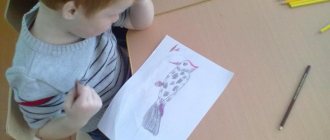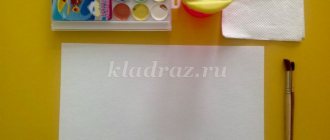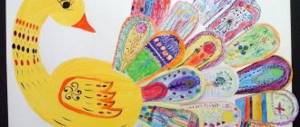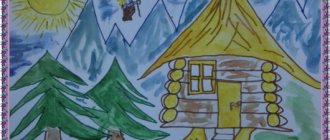In addition, we use a simple pencil of medium hardness (HB), drawing paper and tinted paper for drawing with pastels. The image of the rooster is performed in stages. We start by drawing the diagram on drawing paper, drawing out the details of the bird. Then we transfer the drawing onto tinted paper and work on it with oil pastels, but you can also complete the work on plain paper.
.
On a piece of drawing paper, using a simple pencil, draw two ovals. One larger oval will be the body, and above it a smaller oval will be the head of the rooster. We connect the large and small oval with a line - the bend of the neck.
From the large oval downwards we draw two lines - the legs of the rooster.
.
Draw a triangle for the bird's beak. From the large oval to the right we outline the tail of the rooster in a sharply curved arc.
Draw a comb line above the oval of the head.
We place two semicircles of earrings under the beak.
Add the bend lines of the neck.
Draw the rooster's legs crosswise.
.
Inside the large oval we outline a wing oval with a slightly pointed end.
Draw the contours of the “pants” and the lower edge of the tail with smooth lines.
.
Draw the scallop teeth. In the oval of the wing we draw plumage lines.
Add a pattern of feathers to the tail.
.
We draw the “pants” of the legs and paws with the sharp protrusion of the spurs.
We transfer the drawing onto tinted paper. Why do we shade the back side of the paper sheet with the pattern. We apply it with the shaded side to a sheet of tinted paper and, tracing the outline of the drawing, transfer the image to the tinted sheet.
With light strokes we cover the plumage of the head, the upper part of the wing and some tail feathers with light brown chalk.
.
Use red chalk to draw the comb, earrings and tail feathers.
We go through the remaining places in lilac. We specify the plumage of the tail and wing with black chalk. We go over the head and scallop with red-brown chalk.
- I suggest drawing a real rooster. Like this one.
And he is easy to draw. We take ovals as a basis. There are three of them - head, body, tail.
Let's give our cockerel a shape.
We draw the tail and head in detail.
This is how you get a cockerel.
Typically, the step-by-step drawing of all animals begins with drawing two ovals. The step-by-step drawing of a rooster is indicated in the following diagram:
The scheme is very simple. After drawing the rooster, you can paint it in bright colors.
There is also an option, drawing a rooster.
We start drawing with a circle, this will be our body, draw a beak and an eye, a comb and a head. Now, draw the feathers and wing, all steps need to be repeated carefully according to the photo in the picture
All you have to do is draw a fluffy tail and you’re done, beautifully paint it with bright colors, like a handsome rooster
And you can draw such a rooster using a child’s hand, complete the rooster’s legs and beak, comb
This is what the beautiful rooster looks like, the hero of many of our favorite fairy tales from childhood.
Drawing a rooster is quite easy. Try to complete your drawing following the given diagram, like this:
Or like this:
Could be so:
And like this:
I can say for sure that the classically colored cockerel, which is depicted in all folk tales, is now found, but you can also see cockerels of different breeds with completely different feather colors.
I will give an example of the simplest scheme for drawing a cockerel, but you can decide for yourself how to color it in a more interesting way.
Rooster
- This is a male chicken; he differs from his female by a large comb, as well as a lush multi-colored tail. The rooster is also a symbol of France, and in Russian folklore this bird is the owner of a heroic character that comes to the aid of the weak.
Also, in Slavic mythology, during the construction of a house, a black rooster was sacrificed.
Now let's look at an example of drawing a cartoon cockerel
, for this we will use a step-by-step drawing scheme, which will greatly simplify the entire process:
We color the finished drawing; you can pair the rooster with a hen and chicks, or simply draw it on a green meadow under a clear blue sky:
In order to draw a Rooster using pencils step by step, then for this you need. Pencils, white paper, skillful hands, and, most importantly, a photo or video - a diagram.
First we draw the head and body of the rooster. Then you need to start drawing the wings and beak, tail and legs. look at how it is drawn in the picture, and you will be able to draw a rooster very easily.
The rooster is a very attractive poultry due to its bright red comb and colorful tail.
You can draw any animal in different styles. I offer two options on how to draw a rooster with a pencil step by step
.
The first option looks more like a real bird and is drawn as follows:
The second option is quite simple - for the lazy or for the youngest artists.
To draw a rooster with a pencil step by step, you will need a simple pencil, an eraser and watercolors or colored pencils.
The first step is to draw the outline of the head. Next, add a comb on top, consisting of 5 pointed parts, and below, draw something that vaguely resembles a triangle, which will serve as the contour of the lower border of the plumage of the head. Then we draw a beak on the head, and under it a beard, consisting of two parts.
Moves on to drawing the body and wings. Using several lines we draw the outline of the tail (the lines go down). Then we draw the paws and move on to decorating with paints or colored pencils.
In order to draw a rooster, we need several geometric shapes: circle, oval, semicircle, triangle, line.
So, the first thing I did was draw a line drawing of a rooster using an HB pencil:
Then I lightened all the lines with nag and started drawing the rooster with colored pencils. I decided to start with the tail, so as not to accidentally overwrite what had already been drawn with my hand. And first of all, I used a black pencil, then starting from the darkest tone.
As we moved from left to right, the design of the rooster's tail began to take on more realistic shapes. To convey the shine of the feathers, I used several shades of blue and green. I won’t list them, it’s easier to say that the entire drawing of the rooster took more than half a box of pencils.
The general approach to drawing feathers was the same - the darkest areas were painted first, then a certain color was introduced (or rather, several shades at once) and finally polished. I used exactly the same approach in drawing the yellow feathers:
As you can see, there were quite a lot of yellow feathers on the rooster. If you do not fall into excessive realism or hyperrealism, then it is enough to understand the general principle of how the feathers are arranged and what shadows and shades they provide. And then it is no longer possible to thoroughly copy every smallest feather, but to recreate a more general picture, where exactly the character of these feathers will be conveyed, i.e. they may even be located in slightly different places or there may be fewer of them than in the original, but this will not make them lose their realism.
In general, there are quite a lot of complex elements in drawing a rooster, especially for beginners. These include numerous feathers, shadows, shimmer, and a rooster’s comb with an interesting pimply texture. Therefore, do not rush to complete the entire drawing at once, in one sitting. When painting the rooster's crest, I used several shades of red, as well as cool purple colors in the shadow areas. I went over it a little with a white gel pen, imitating the pimply surface of the comb. I really didn’t want to get too bogged down in copying here, so I allowed myself to heartily poke with my pen in a chaotic manner. It turned out quite plausible in my opinion




